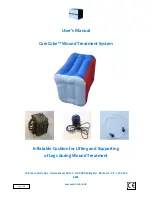
www.petsafe.net
11
he has a history of misbehaving. However, setting up a situation as a training session can dramatically
improve your chances of success. When doing this aim at stopping the behaviour as it begins and before
the distraction or intention to misbehave becomes intense.
• If your dog reacts to the training by hiding or acting fearful, check your body language, be consistent,
reduce the level of the stimulation and redirect his attention to a simple and appropriate behaviour
such as the “Sit” command. Do not reassure him verbally for acting fearful as this can reinforce the
behaviour. Act normally and continue with the training.
•
Never use the Remote Training Collar to correct or eliminate any form of aggressive behaviour. If
your dog exhibits aggressive behaviour please consult an experienced dog trainer. However, obedience
training often reduces many aggression problems.
•
The objective is to train your dog top respond to your spoken command at distance using no stimulation
and tones. The collar therefore should only be required after training is complete to reinforce commands
that have not been obeyed and stop repeated unwanted behaviour
____________________________________________________________________
Before Starting Training
• It is advantageous, although not essential, to let your dog wear the collar for two or three days
prior to using it for training.
• Create an association with the “Good Dog” Tone by pressing the Side Button followed
immediately by giving your dog a treat. Do this at least 50 times over two days. You can use his
dinner kibble for this and make it a feed time routine for two days.
• Your trainer has three buttons:
– Side Button is “Good Dog” Tone.
– Top Button is “Bad Dog” Tone.
– Lower Button is stimulation.
• Ensure that your dog never wears the collar for more than 8 hours a day. Even though your dog
may only wear it for 8 hours move the collar slightly to other positions on his neck regularly. This
will minimise the possibility of pressure spots being created on his neck where the electrodes touch.
• Find your dog’s “Recognition Level” – the lowest level at which he begins to notice the collar’s
sensations.
• Determine what commands will be used to train your dog to obey. These must be simple one
word commands where possible and should be used consistently by everyone interacting with
your dog. This is essential especially for family members.
• Give all commands with a normal tone of voice, encourage and praise dependent upon the
personality of the dog. Do not get harsh with any command, it is not necessary. Teach him to
obey a normal tone of voice. With the remote collar and lead, you always have the ability to
control and guide.
• It is always an advantage if your dog has undergone some training and understands basic
commands. The collar is very effective at reinforcing and prompting known commands.
• Always watch to ensure the dog does not need to defecate or urinate when training. This can
bethe biggest distraction and will make you think he cannot feel the stimulation. Allow him to
defecate and urinate before training.
• Make your training sessions fun. Vary your speed of walking and show pleasure when your dog is
doing as required.
• Never loose your patience.
• High value treats such as hot dogs can be used at any stage to reward your dog but do not be
concerned if he does not wish to take them.
• Remember that these instruction on how to train your dog may involve you doing the exercise
many times over a number of days and weeks to ensure your dog learns at his own pace and
ability. Be pleased with small improvements from each training session.
Summary of Contents for comfortfit trainer
Page 65: ...www petsafe net 65 ...
Page 66: ...66 www petsafe net ...
Page 67: ...www petsafe net 67 ...












































